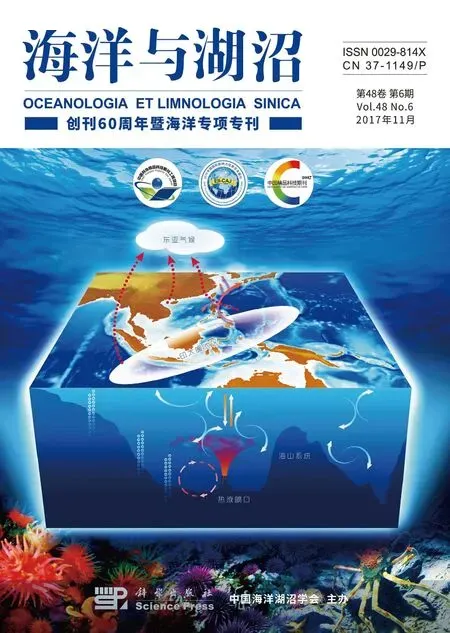西太平洋若干沟-弧-盆体系及板内岩浆成因研究进展*
张国良 王 帅 张 吉 罗 青 李铁刚,
(1. 中国科学院海洋研究所 海洋地质与环境重点实验室 青岛 266071; 2. 青岛海洋科学与技术国家实验室 海洋地质过程与环境功能实验室 青岛 266061; 3. 国家海洋局第一海洋研究所 青岛 266061)
地球是太阳系及系外明确已知有板块构造的唯一一个行星(Nimmoet al, 2000; Lenardicet al, 2012)。板块构造启动以后, 固体地球内外物质交换的形式发生了巨大改变(Korenaga, 2013; Duncanet al,2017)。大洋板块俯冲是板块构造的关键环节, 不仅形成岛弧岩浆作用, 也使得大洋岩石圈重返地幔, 重返地幔的大洋岩石圈(洋壳或岩石圈地幔部分)又可以重新熔融形成板内岩浆作用(如地幔柱作用)(Hofmann,1997; Sobolevet al, 2005)。西太平洋(黄帝岭-夏威夷以西)分布了地球上 60%以上的沟-弧-盆体系, 其中聚集了全球几乎所有的洋内俯冲带, 并有全球分布密度最高的板内火山活动(海山和洋底高原)(图1)。主要岛弧系统从北向南, 包括阿留申俯冲带、勘察加俯冲带、琉球俯冲带、伊豆小笠原-马里亚纳俯冲带、雅浦-帕劳俯冲带、马努斯俯冲带、汤加-科玛迪克俯冲带, 及其相关的弧后盆地系统(图 1)。尽管这些岛弧俯冲带距离大陆边缘远近不同, 但对岛弧火山岩的放射性定年表明, 这些岛弧都形成于始新世以来(<50Ma)(Arculuset al, 2015a; Reaganet al, 2013)。岛弧开始形成的年龄, 大致对应于黄帝岭-夏威夷海山链所记录的太平洋从北西西向北北西转向的时间(Setonet al, 2015)。因此, 有研究普遍认为西太平洋板块俯冲与太平洋板块向西的运动转向有关(Setonet al, 2015)。但是, 关于太平洋向西运动和西太平洋俯冲带形成的因果关系还存在较大争议(Setonet al,2015)。尤其是, 中国陆地中生代以来存在古太平洋板块的向西俯冲, 但没有证据显示现代西太平洋俯冲带与古太平洋板块俯冲的相关性(Zhouet al, 2000;Sunet al, 2007)。也有研究认为, 太平洋向北运动期间形成了南北方向转换断层, 后来这些转换断层在始新世以后转换为俯冲带(Uyedaet al, 1972; Muelleret al, 1991; Collotet al, 1995)。为了研究西太平洋岛弧的发育历史, 国际上在近年来对马里亚纳岛弧系统开展了一系列大洋钻探工作(IODP 350-352)。其中研究早期岛弧演化, IODP 350航次在伊豆后弧进行了钻探。IODP 351航次基于对IBM岛弧形成的问题研究, 在九州-帕劳海岭的西侧进行钻探, 获得的样品对于理解初始俯冲和随后的岛弧演化有重大意义(Arculuset al, 2015b)。IODP 352航次通过对前弧的钻探来验证初始俯冲的过程。通过钻探获得的样品和数据, 有助于对弧前的地壳演化和初始俯冲过程有更好的了解(Pearceet al, 2015)。
大洋板块在海沟处俯冲进入地幔之前经历了脱水/熔融作用, 这是导致岛弧地幔楔加水熔融的关键因素(Pearceet al, 1995; Kelleyet al, 2006)。通常认为,岛弧和弧后盆地火山岩中较高的挥发分(包括水)含量和广泛的亲流体元素(如Cs, Rb, Ba, U等)富集, 体现了俯冲板块脱水对岛弧岩浆的影响(Pearceet al, 1995;Kelleyet al, 2006)。大洋板块在俯冲带经历的脱水或熔融过程, 会直接影响残留并最终进入地幔的板块组成。然而, 关于俯冲板片是否通过部分熔融对岛弧岩浆产生贡献, 还存在较大争议(Castilloet al, 2009)。通过同一岛弧的不同俯冲板块组成、或通过同一俯冲板块俯冲形成的不同岛弧系统火山岩进行对比研究,有助于分析俯冲板块组成变化对岛弧岩浆的影响,从而揭示俯冲过程因素和板块熔融/脱水过程对岛弧系统岩浆成因的控制机理(Castilloet al, 2009)。弧后盆地通常是由于板块俯冲在岛弧后侧形成的弧后拉张所致。西太平洋的海盆, 除了与已知岛弧的弧后拉张有关以外, 一些则并没有对应明确的现代岛弧。如菲律宾海盆、加洛林海盆、南海海盆等(图 1)。由于这些海盆都位于现代西太平洋岛弧靠陆地一侧, 通常认为这些海盆的形成也与弧后拉张有关(Sunet al,2016; Deschampset al, 2002)。弧后拉张形成的岩浆主要反映了上地幔源区的组成。西太平洋弧后盆地玄武岩的地球化学组成显示, 岩浆的地幔源区广泛存在Dupal异常。Dupal异常是指地幔的Pb同位素组成在208Pb/204Pb vs.206Pb/204Pb图上位于北半球参考线以上(Hart, 1984; Dupréet al, 1983)。Dupal异常通常在南半球的中低纬度地区广泛存在, 因此通常也叫南半球同位素组成异常。后来研究发现, 无论是在南半球还是北半球的西太平洋海盆, 也存在着 Dupal异常(Hickey-Vargas, 1998; Floweret al, 2001; Miyazakiet al, 2015)。关于Dupal异常是否来自南半球软流圈, 或是西太平洋地幔固有的组成特征, 还是西太平洋地幔受到俯冲板片熔融作用并对弧后盆地上地幔产生混染的结果, 目前还有很大争议(Hickey-Vargas, 1998;Floweret al, 2001; Miyazakiet al, 2015)。
西太平洋除了广泛存在沟-弧-盆体系以外, 还是全球大洋板内岩浆较为集中的海区。马里亚纳岛弧前缘的太平洋板块具有全球最高的海山分布密度, 多个海山链交错分布。除了海山以外, 这里还分布着多个洋底高原。如Ontong Java洋底高原、Manihiki洋底高原、Hikurangi洋底高原、本汉姆隆起(Benham)、Urdaneta隆起、加洛林洋底高原等。根据基岩组成类型(拉斑或碱性玄武岩)和年龄分布规律, 可以分为有年龄序列和无年龄序列两种不同类型。典型的海山链有年龄序列, 其形成最可能来自地幔柱活动, 源区可能与俯冲-再循环的俯冲大洋板块有关(Abouchamiet al, 2005)。近年来, 研究认为一些海山的形成(尤其是无年龄序列的海山)可能不需要地幔柱的存在。例如,大洋板块内部剪切带形成的岩浆活动(Conradet al,2011), 浅部物质小尺度地幔对流形成的岩浆活动(Hoernleet al, 2011; Kipfet al, 2014)。一部分海山的形成明显不与地幔柱有关。例如, Petit spots的海山形成于古老的太平洋之上的年轻海山, 不是来自地幔柱活动(Hiranoet al, 2006)。海山是由板内火山活动形成, 实际上西太平洋海山大多由碱性玄武岩组成。但是, 碱性玄武岩的形成机制还存在着较大争议(Kogisoet al, 2003; Dasguptaet al, 2006)。认识西太平洋海山的形成机制, 必须对碱性玄武岩的形成机制进行详细研究。
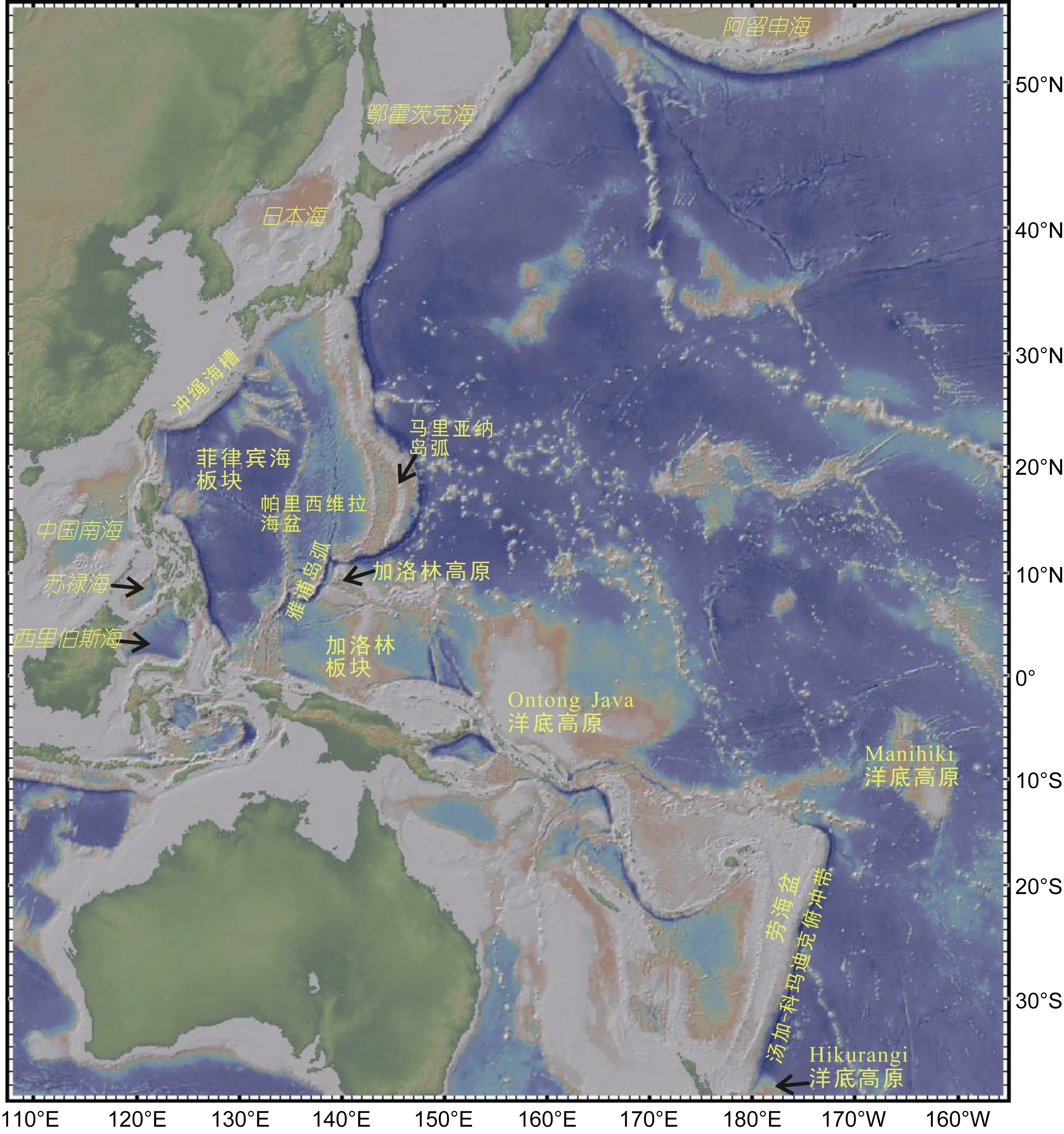
图1 西太平洋构造和地形分布图Fig.1 Topography and tectonics of the western Pacific
1 西太平洋沟-弧-盆体系和板内火山活动的年龄框架
1.1 主要沟-弧-盆体系的构造和年龄
伊豆-小笠原-马里亚纳岛弧、雅浦岛弧和帕劳岛弧构成了菲律宾海板块的东南边界, 是菲律宾海板块、太平洋板块和卡罗琳板块之间的汇聚型板块边界,也是全球典型的在大洋内部发育的岛弧。从马里亚纳岛弧到九州-帕劳海脊, 自东向西依次分布着: 马里亚纳岛弧, 其岛弧火山活动仍旧活跃, 弧前区有古近纪的火山岩; 马里亚纳海槽, 是活动的弧后盆地; 西马里亚纳海脊, 是岛弧火山活动已经停止的残留弧;帕里西维拉海盆, 是停止扩张的弧后盆地, 中部帕里西维拉裂谷为海盆的扩张轴; 九州-帕劳海脊, 是岛弧火山活动已停止的残留弧(图1)。
在西太平洋汇聚板块边界中, 马里亚纳岛弧最为典型。马里亚纳岛弧发育了完整的“沟-弧-盆”体系,发育成熟程度高(Kimet al, 2009), 研究程度也相对较高。Karig最先提出岛弧裂解和弧间扩张的假说(Karig, 1971, 1974), 认为马里亚纳俯冲带的后撤形成了一系列残留弧和弧后海盆。随后进行的DSDP59航次的结果表明, 在九州-帕劳海脊的 448站位获取的安山玄武岩年龄为 34—32Ma, 帕里西维拉海盆的449、450站位的基底年龄分别为24和17Ma (Scottet al, 1980)。西马里亚纳海脊的451站位获取的火山岩年龄为 11Ma。DSDP60航次钻探结果表明马里亚纳海槽是早上新世以来形成的。马里亚纳岛弧的构造运动和火山活动至今仍然活跃。马里亚纳岛弧火山岩类型为玄武质、安山质和英安质, 年龄不超过上新世。前弧地区存在拉斑和钙碱性系列的火山岩, 它们的产生可能与始新世到早渐新世, 晚渐新世到古新世的两次大规模的火山活动有关(Shirakiet al, 1978)。ODP125和 ODP126航次在伊豆-小笠原-马里亚纳弧前区获得的岩石以玻安岩为主, 基底年龄为始新世—早渐新世(Lapierreet al, 1992), 海沟内侧沟壁岩石类型以拉斑玄武岩、安山岩为主(Sternet al, 2003)。这些研究成果支持 Karig(1971)提出的弧间扩张和残留弧模式。因此, 本文总结出马里亚纳岛弧早渐新世以来的演化历史: 30Ma左右, 初始IBM岛弧开始裂解, 岛弧火山作用逐渐停止, 四国海盆、帕里西维拉海盆开始扩张; 15Ma左右, 四国海盆和帕里西维拉海盆扩张停止, 现今九州-帕劳海脊残留弧基本形成;11Ma左右, 伊豆-小笠原-马里亚纳岛弧处的火山活动重新活跃; 5Ma左右, 岛弧开裂为西马里亚纳海脊和马里亚纳岛弧, 扩张形成马里亚纳海槽。
雅浦岛弧系统东侧受卡罗琳洋底高原俯冲, 东北部与马里亚纳海沟近直角相交, 北连帕里西维拉海盆扩张中心, 南接帕劳岛弧。雅浦岛弧基本由变质岩组成, 火山岩也有零星分布。缺乏活动性的岛弧火山活动(Shiraki, 1971; Hawkinset al, 1977, Oharaet al,2002); 加洛林洋脊从东向西俯冲于雅浦海沟, 但弧后扩张盆地并不发育(Satoet al, 1993, Kobayashi,2004)。成熟岛弧的沟弧间距一般在100—200km(Satoet al, 1993; Kimet al, 2009), 而雅浦岛弧的沟弧间距异常短, 约为50km (Fujiwaraet al, 2000)。弧前无明显沉积物发育, 增生楔缺失。地震活动性很弱, 震源深度不超过40km(Oharaet al, 2002)。关于雅浦岛弧的成因并没有一致的结论。McCabe等(1983)研究认为在早中新世时, 卡罗琳洋脊的碰撞使雅浦岛弧的火山作用停止, 并导致雅浦的弧前地区遭受俯冲侵蚀。Fujiwara等(2000)通过地球物理的结果认为现今雅浦岛弧的主体部分代表帕里西维拉海盆的洋壳。Ohara等(2002)通过研究雅浦海沟的橄榄岩和火山岩认为, 橄榄岩来源于岛弧拉斑玄武岩浆产生之后的残余地幔物质, 是与雅浦弧前环境相关的超基性岩,并不是来自帕里西维拉海盆地或者捕获的洋壳岩石圈物质。
帕劳岛弧火山岩类型为玄武岩、安山岩和英安岩,其 K-Ar年龄为 37.7—20.1Ma (Hastonet al, 1988,1991)。帕劳海沟和雅浦海沟的俯冲速率都很低(帕劳海沟为3—0mm/yr, 雅浦海沟为6—3mm/yr), 远小于马里亚纳海沟的俯冲速率(40—30mm/yr)。马里亚纳、雅浦、帕劳岛弧形成了一个连续的岛弧体系, Matsuda等(1997)研究认为帕劳、雅浦、马里亚纳岛弧可能分别代表岛弧演化三个不同阶段: 帕劳岛弧代表岛弧发展的初始阶段; 雅浦岛弧代表岛弧的埋藏或区域变质阶段; 马里亚纳岛弧代表岛弧发展的成熟阶段。
西太平洋的海盆的形成主要与弧后拉张环境有关, 主要形成于新生代以来(表1)。其中, 菲律宾海是西太平洋沟-弧-盆体系最大的海盆。九州-帕劳海岭及其西马里亚纳海岭将菲律宾海分为三部分; 菲律宾海的西部由西菲律宾海盆和奄美高原组成。西菲律宾海盆是菲律宾海最大最深的海盆, 对于海盆的形成目前还存在较大的争议(Hildeet al, 1984)。其中最主要的观点是菲律宾海盆的打开分为两个阶段: 在中央盆地断裂带第一阶段在 60—45Ma沿东西向打开,在这一阶段形成的高原和隆起可能是由岩浆活动形成的; 第二阶段在45—35Ma沿北东—南西向平行于九州-帕劳海岭打开(Hildeet al,1984; Okinoet al,1999)。
卡罗琳板块位于太平洋板块, 菲律宾海板块, 印度-澳大利亚板块之间, 主要由卡罗琳海盆、索罗尔海槽、西卡罗琳洋脊构成。索罗尔海槽为卡罗琳板块与太平洋板块的分界(Bird, 2003), 将卡罗琳洋脊分为近乎平行的两部分: 东卡罗琳洋脊和西卡罗琳洋脊。海底地磁条带研究显示加洛林海盆年龄为两个阶段:42—25、18—13.7Ma (Bracey, 1975)。DSDP 62、63钻孔的研究结果确定了卡罗琳基底的年龄为37—24Ma (Gainaet al, 2007)。最初研究认为, 卡罗琳海盆沿欧里匹克隆起(Eauripik Rise)东西向扩张, 但后来的研究表明海盆的扩张方向为南北向(Braceyet al, 1974)。一般认为, 卡罗琳板块向南俯冲, 弧后扩张形成了卡罗琳海盆(Weisselet al, 1978)。
菲律宾海盆以西的亚太地区还存在这一系列新生代时期形成海盆, 这里处于欧亚板块的巽他陆架、澳大利亚-新几内亚板块及太平洋-菲律宾海板块的交界处, 具有复杂的构造环境。主要包括: 南海、苏禄海、西里伯斯海。南海位于欧亚大陆、太平洋、印度洋的交界处, 形成于东南亚大陆裂解后形成的扩张盆地。通过地磁条带和钻孔玄武岩年代学研究, 认为南海扩张发生在33—16Ma(Briaiset al, 1993; Liet al,2014)。由于南海海盆的独特构造背景, 关于南海扩张形成和演化的动力学原因是极具争议的。南海扩张有关的动力学模型, 包括印支半岛的构造侵入(Briaiset al, 1993)、作为弧后扩张盆地而形成(Karig, 1973;Hildeet al, 1977; Sunet al, 2016)、海南地幔柱的影响(Floweret al, 1998), 或者与古南海(proto-South China Sea)俯冲拖拽有关(Holloway, 1982; Tayloret al,1982)。2014年, IODP 349航次首次对南海海盆基岩进行了科学钻探, 获得了东部次海盆和西南次海盆残留脊附近的玄武岩, 证实了南海海盆是由海底扩张形成的洋壳组成。随后的IODP 367、368航次连续对南海北部进行了钻探, 也获得了洋壳玄武岩。详细的岩石学和地球化学研究, 可以为南海形成和相关地幔深部信息提供重要约束。
苏禄海西与北婆罗洲的沙巴州相邻, 东与菲律宾群岛相邻, 南边苏禄群岛将苏禄海与西里伯斯海分开, 北边巴拉望岛将南海与苏禄海隔开。内部北东向的卡洛延岭将苏禄海分成了西北水深 1000—2000m和东南水深 4500—5500m两个海盆。整个苏禄海西北海盆具有较厚的岛弧型的洋壳(Murauchiet al, 1973; Jolivetet al, 1989)。苏禄海东南海盆具有典型的洋壳特征, 洋壳向苏禄海沟的方向逐渐倾斜。关于苏禄海东南海盆的成因主要存在两种争议: 弧后扩张(Uyedaet al, 1979; Mitchellet al, 1986)和自班达海到苏禄海一个连续的洋盆(Leeet al, 1986; Spadeaet al, 1996)。也有研究认为苏禄海东南海盆是弧后扩张的结果。地磁条带异常及周边岛屿的构造演化相关研究认为, 自班达海到苏禄海最初是一块连续的大洋基底(Leeet al, 1986; Parsonset al, 1977)。地磁条带异常研究认为, 苏禄海盆的打开年龄在 41—45Ma(McCabeet al, 1982; Muelleret al, 1991)。Taylor和Hayes认为N80°E地磁异常具有低振幅, 低强度的特点与南海的洋壳有密切联系, 苏禄海为南北向打开的(Tayloret al, 1983)。在古近系时西里伯斯海在卡洛延岭的位置俯冲到苏禄群岛的下面, 在早渐新世的时候(30—37Ma)岛弧南移, 此时苏禄海东南海盆在苏禄海岭北边以弧后扩张的形式打开(Mitchellet al,1986)。据苏禄海盆的地球动力学研究, 苏禄海的打开及其俯冲终止经历了10—15Myr (Uyedaet al, 1979)。而关于关闭的原因可能与巽他陆架的侧向碰撞有关,并导致了苏禄海海盆的倾斜(Rangin, 1989)。Leg 124-768的生物地层样品得到了苏禄海洋壳的年龄最少为17—18Ma (Muller, 1991; Roeser, 1991), 根据地磁条带异常获得的苏禄海盆的打开年龄在 30—37Ma(Müller, 1991; Roeser, 1991)。对于西里伯斯海的研究对其成因有三种观点: 大陆边缘裂解的盆地, 古老海盆的碎片或弧后扩张(Murauchiet al, 1973; Leeet al,1986)。对于这两个海盆的形成年龄的研究主要基于地磁条带、热流值、生物地层、及同位素地球化学测年方法。西里伯斯海的年龄主要通过地磁条带, 热流值及其生物地层得出的形成时间在42—47Ma(Nicholset al, 1999; Shyuet al, 1991)。然而, Lee 和McCabe对地磁条带和热流值的解释为西里伯斯海的打开时间为65—72Ma (Leeet al, 1986)。根据取自卡洛延岭Site769及Site771的玄武岩样品进行K-Ar测年得到卡洛延岭的年龄在23.9—25.8Ma (Bellonet al,1991)。
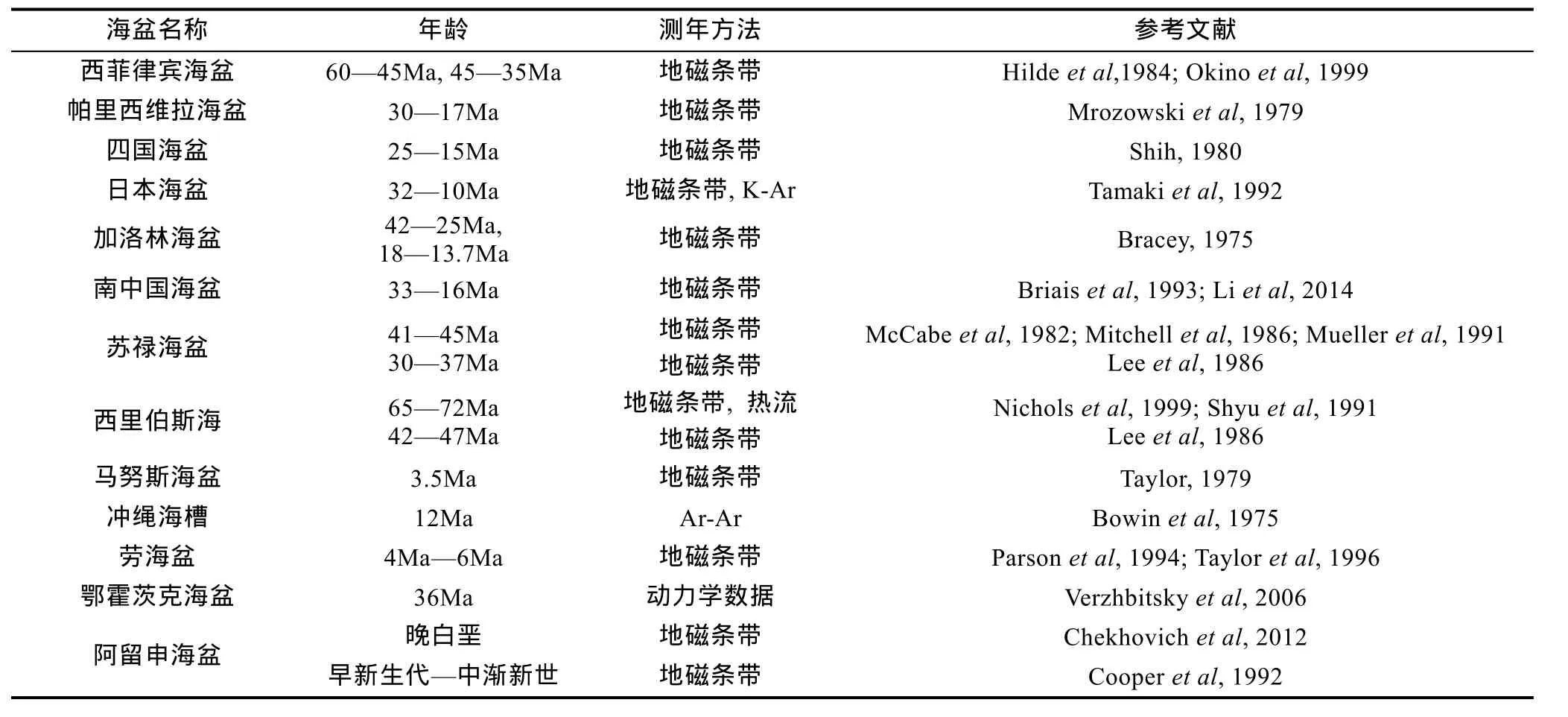
表1 西太平洋主要海盆的形成时代Tab.1 Ages of major ocean basins in the Western Pacific
1.2 板内火山活动年龄和分布
西太平洋存在大量板内火山活动形成的海山链。其中, 马里亚纳岛弧以东, 是全球大洋海山最为集中的海区。这里有Japanese-Joban链(103.6—94 Ma)、北Wake (113—109 Ma)及南 Wake海山链(119.7—89.7Ma)、Magellan海山链(117.8—87.1Ma)、Gilbert海山链(77.9—65.7Ma)、Tokelau 海山链(72.1—66.1Ma)等。相关研究认为, 这些海山大多与位于中太平洋的超级地幔柱在早白垩—晚白垩期间的活动有关(Suetsuguet al, 2009)。南半球西太平洋的主要海山链有路易斯维尔(Louisville)海山链, 其最老一端与汤加-科玛迪克岛弧相交, 年龄为 78Ma (Kopperset al,2004)。这是仅次于黄帝岭-夏威夷海山链以外的第二长海山链, 通常被认为形成于一个长期的地幔柱活动。西太平洋海山链还存在于边缘海盆中, 如, 南海海盆中存在多个海山, 尤其是, 南海扩张停止后沿残留脊形成了一个海山链(~16Ma)(Liet al, 2014)。
除板内海山以外, 也形成了大量规模巨大的洋底高原。其中, Ontong Java高原是现存海洋中最大的洋底高原, 形成于124—119Ma期间的一个地幔柱活动(Larson, 1997)。最近的研究认为, Ontong Java洋底高原只是代表了这次地幔柱活动形成的洋底高原的一部分, 而西太平洋的Manihiki和Hikurangi洋底高原也是该次地幔柱活动的产物, 由于中生代时期古太平洋扩张中心的活动, 将Manihiki和Hikurangi洋底高原与Ontong Java洋底高原分离并位于现在的位置(Taylor, 2006)。Benham隆起位于西菲律宾海盆的西部边缘, 是一个相对较小的长方形隆起。关于Benham隆起的形成时间: McKee使用Benham隆起南侧的Site 292的样品用K-Ar法测得了年龄在37.5Ma(McKee, 1975)。Hilde等(1984)认为Benham隆起是在菲律宾海打开的第二阶段, 沿中央海盆断裂带通过巨量岩浆活动形成。相对应地, 位于东北部的Urdaneta隆起与Benham隆起相对中央裂谷带具有相同的距离, 被认为是同一隆起, 岩浆作用之后通过转换断层分开成为现在的两个隆起, 然后伴随海盆的打开运动到现在的位置(Hildeet al, 1984)。Karig(1975)认为Benham隆起可能代表了一种沿吕宋岛东边的俯冲结束的挠曲, 也可能是代表了一种西菲律宾海盆形成后的大规模的岩浆活动。对Benham隆起的岩石学及其地球化学性质的认识, 主要是基于在 DSDP Site292钻孔在 Benham隆起南缘的玄武岩岩芯。Benham隆起的基底玄武岩主要为碱性玄武岩, Pb同位素组成显示玄武岩具有Dupal异常。Dupal异常原因可能是其形成时位于南半球Dupal异常区, 或是形成过程受到菲律宾海板块岩石圈地幔的混染(Daleet al, 2008)。
加洛林洋底高原-海山链是新生代以来太平洋北半球唯一一个与夏威夷海山链平行的海山链(图 1)。自西向东海山链(Truk、Ponape、Kusaie)的年龄逐渐变年轻, 且海山玄武岩同位素组成也非常均一, 被认为是来自一个地幔柱活动(Keatinget al, 1984)。加洛林海山链与位于雅浦岛弧东侧的东、西加洛林脊相连接, 两者之间存在一个索罗尔海槽。但东、西加洛林脊的基底性质长期以来缺少基岩采样, 这使得两者的成因一直神秘莫测。有研究推测西加洛林脊代表一个曾经活动的岛弧, 其残留俯冲带位于西加洛林脊的南侧。2015年热带西太平洋专项对加洛林脊进行了详细的岩石基底采样, 发现均由洋岛型玄武岩组成。这说明加洛林洋脊可能代表分裂的洋底高原, 与该洋底高原以东的加洛林海山链可能具有成因联系。
2 主要科学问题和研究进展
2.1 西太平洋地幔组成异常成因研究
Dupal异常最早是由 Hart(1984)提出, 通常是指玄武岩在208Pb/204Pb vs.206Pb/204Pb 和207Pb/204Pb vs.206Pb/204Pb相关图上位于北半球参考线之上。最早发现于南半球中低纬度的洋岛玄武岩, Dupal异常(也称南半球同位素异常)最初被认为是南半球软流圈专有特征, 如印度洋、南大西洋(Hart, 1984, 1988; Agranieret al, 2005)。后来发现南半球的印度洋和大西洋的洋壳玄武岩普遍具有Dupal异常, 被称为印度洋型玄武岩。相应地, 太平洋和北大西洋的洋壳玄武岩通常不存在Dupal异常, 被称为太平洋型玄武岩。上地幔存在Dupal异常的起源(或印度洋型地幔的来源)还存在不同的认识, 包括地幔柱的混染、大陆下地壳或岩石圈地幔拆沉/混染、再循环沉积物的影响等。然而, 随着Dupal异常在北半球的洋中脊玄武岩(MORB)中发现[例如在北冰洋Gakkel洋脊(Goldsteinet al, 2008)、菲律宾海(Hickey-Vargas, 1998)], 已经认识到北半球欧亚大陆边缘海盆软流圈也存在Dupal异常。随着研究逐渐增多, 发现西太平洋海盆也普遍存在Dupal异常, 例如菲律宾海、日本海、马里亚纳海槽、劳海盆等(Hickey-Vargas, 1998)。西太平洋的岛弧玄武岩也主要体现了Dupal异常的特征, 或者是印度洋型玄武岩(Castillo, 1996)。然而, 关于西太平洋海盆玄武岩Dupal异常的来源还存在很大争议, 其与印度洋Dupal异常的关系存在不同认识(Hickey-Vargas, 1998,Floweret al, 2001)。北半球西太平洋的扩张海盆玄武岩(如菲律宾海盆、Mariana海槽、帕里西维拉海盆)的Dupal异常来源一直存在争议: 如来自于向北迁移的南半球软流圈特征(Hickey-Vargaset al, 1998), 还是来自东亚大陆下部混染的软流圈(Floweret al,2001)。尽管如此, 长期以来仍未知道西太平洋Dupal异常是否延伸到亚洲大陆下部的软流圈。
介于三个板块之间的南海特殊位置对于认识北半球软流圈的 Dupal异常分布有重要意义。在“海洋专项”的资助下, 作者对南海IODP 349航次获得南海扩张期玄武岩进行了详细的元素和同位素(Sr-Nd-Pb-Hf)地球化学分析, 发现南海扩张期海盆玄武岩具有Dupal异常(图2), 同位素组成与印度洋洋中脊玄武岩相似(未发表), 且南海玄武岩具有很宽的 Pb同位素组成范围(206Pb/204Pb, 17.6—18.6)(图2)。这说明西太平洋菲律宾海板块和中国华南大陆之间的软流圈存在Dupal异常的连续性。同位素地球化学结果也显示,产生南海地幔 Dupal异常的富集端元与菲律宾海板块地幔端元存在明显差异。这显示, 南海软流圈的Dupal异常来源可能与菲律宾海板块不同。菲律宾海盆与南部特提斯洋之间的俯冲带可能阻隔了软流圈向北流动(Floweret al, 1998, 2001)。南海位于印度洋板块以北, 两者被Sunda-Java岛弧隔开。Sunda-Java岛弧自古特提斯洋俯冲以来就长期存在(至少 150Ma以前)(Metcalfe, 2011), 是长期以来东南亚大陆和印度洋之间软流圈之间的天然屏障。古特提斯和印度洋板块的向北俯冲可能导致了 Sunda-Java岛弧俯冲带以北的软流圈向南迁移。因此, 南海的Dupal异常不可能是来自南部的印度洋软流圈流动。南海海底的开始扩张(~33Ma)明显比 Sundaland俯冲带年轻很多,这说明南海玄武岩地幔源区的 Dupal异常是反映了南海裂开之前东南亚大陆下的软流圈特征。为解释南海海盆玄武岩的同位素组成, 作者通过地幔端元混合计算, 认为南海地幔的Dupal异常是在南海打开过程中形成的, 不仅受到大陆裂解过程中大陆下地壳的混染, 还受到了海南地幔柱的影响(未发表)。对南海的地幔端元起源的认识, 对于理解南半球软流圈Dupal异常来源有着重要参考价值。
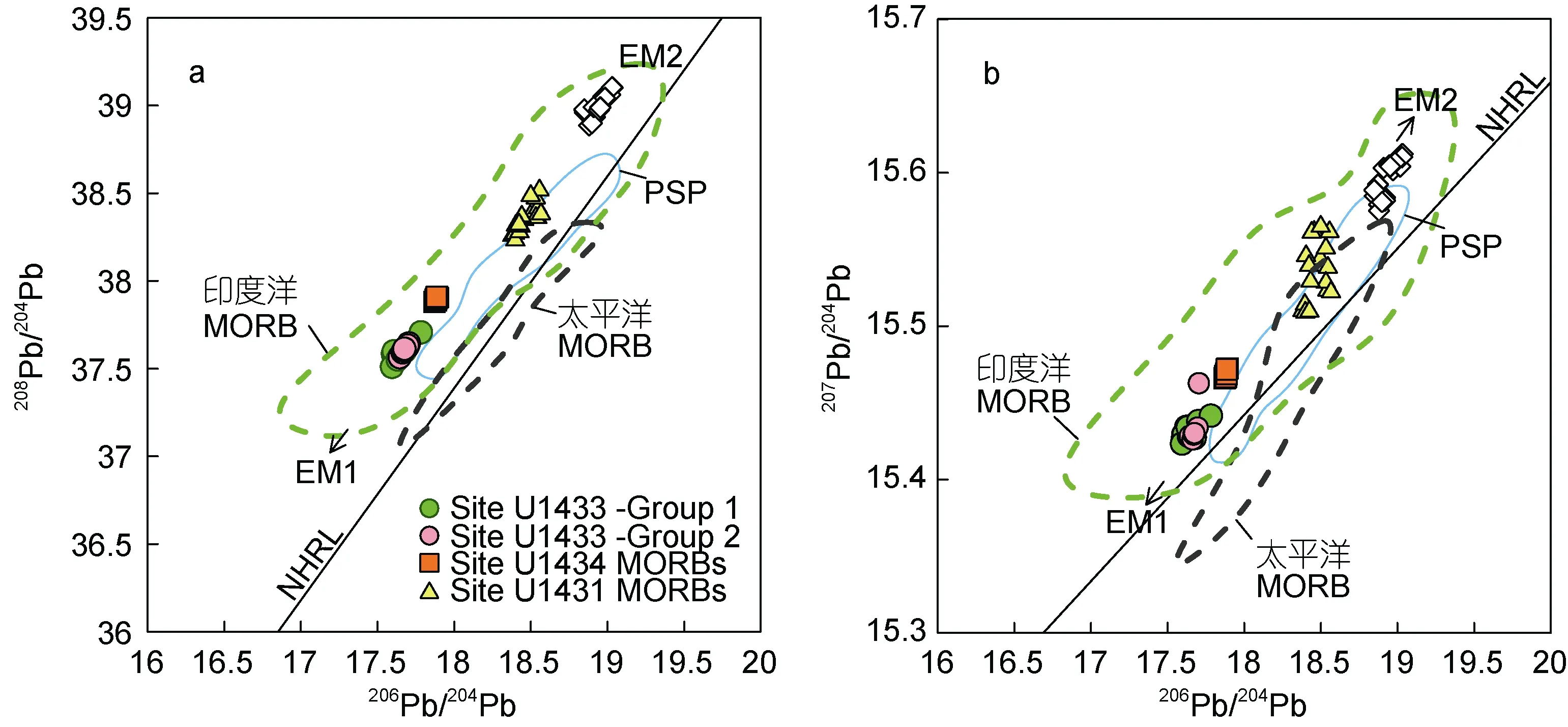
图2 南中国海IODP 349航次玄武岩(U1431-U1434)Pb同位素组成Fig.2 Pb isotope compositions of the South China Sea seafloor basalts collected during Cruise IODP 349
2.2 西太平洋板内岛弧岩浆物质来源研究
位于板块汇聚边界的岛弧俯冲体系是地球上最活跃的构造单元(Pearceet al, 1995)。大洋板块在俯冲带返回地幔的过程中脱水/熔融, 从而直接影响了岛弧岩浆的组成和作用机制。一般认为, 受俯冲大洋板块脱水的影响, 岛弧岩浆的形成是由于弧下地幔楔加水熔融导致的(Pearceet al, 1995)。然而, 有研究认为俯冲板片对岛弧岩浆的贡献不只是含水流体, 而是板片俯冲过程中也发生了部分熔融, 对岛弧岩浆也产生了贡献(Castilloet al, 2009)。目前, 岛弧岩浆的成因机制还存在不同见解。通常认为, 影响岛弧岩浆组成的因素包括弧下地幔楔的组成、俯冲板片的组成变化、以及俯冲过程(如俯冲板片角度、俯冲速率等)。对岛弧岩浆岩的地球化学研究表明, 地幔楔的亏损程度及俯冲物质的组成都会影响岛弧岩浆成分(Johnsonet al, 1999; Elliott, 2003; Turneret al, 2009;Timmet al, 2013; Priceet al, 2016)。同时, 在地球物理探测和数值模拟方面的进展有助于约束俯冲过程的物理条件。其中, 俯冲带的温度结构控制了板片脱水/熔融的条件(van Kekenet al, 2002, 2011; Syracuseet al, 2010), 进而影响岛弧岩浆熔体的产生(Kelleyet al, 2006)。俯冲岩石圈年龄、俯冲带剪切热、俯冲角度及俯冲速率都会影响俯冲带的温度结构(Peacock,1990, 1996; Zellmeret al, 2015)。实际上, 过去关于地幔楔组成和板片组成对岛弧火山影响研究较多, 而关于板片俯冲过程的研究则相对较少。
汤加-科玛迪克俯冲体系的俯冲速率南北差异较大(汤加岛弧北部约为 83mm/yr, 科玛迪克南部约为46mm/yr), 且岛弧岩浆岩的地球化学成分存在明显差异, 是研究岛弧岩浆作用控制因素的理想场所。Ewart等(1987)根据岛弧岩浆岩的微量元素及Nd、O、Sr、Pb同位素数据发现, 从汤加岛弧北部到Kermadec南部, 岛弧拉斑玄武岩和玄武质安山岩从极度亏损高场强元素(high field-strength elements, HFSEs)变化为接近N-MORB型富集HFSE, 指示了岛弧下方的岩浆源区(地幔楔)存在不相容元素亏损程度上的差异。Regelous等(1997)分析了汤加-科玛迪克岛弧年轻岩浆岩的 Th、Sr、Pb同位素数据, 认为沿岛弧的地球化学变化是由于岛弧下部俯冲材料的不同引起的,南部汤加-科玛迪克岛弧岩浆岩中更高的Pb同位素来自于俯冲沉积物的贡献, 而汤加岛弧岩浆岩中的 Pb异常则来自于俯冲洋壳的脱水。Turner等(1997)认为,岛弧岩浆中至少含有四种成分, 包括地幔楔、俯冲沉积物、俯冲海山的火山碎屑及沉积物, 以及蚀变洋壳脱水形成的流体。Ewart等(1998)进一步分析认为, 进入俯冲带的物质的量和成分的不同, 以及上地幔原本的不均一性是导致汤加-科玛迪克岛弧岩浆岩出现南北差异的主要原因: 科玛迪克俯冲带更厚的沉积物导致科玛迪克岛弧岩浆中有更高的Th/U和更具放射性的 Pb同位素, 而汤加岛弧西侧弧后盆地劳海盆的扩张则导致汤加岛弧下方的地幔楔更加亏损。
为了验证温度结构对岛弧岩浆作用的影响及其控制因素, 本项目研究对汤加-科玛迪克岛弧岩浆岩的地球化学数据进行了进一步整理和分析。通过对比发现, 俯冲速率更快的汤加岛弧与俯冲速率较慢的科玛迪克岛弧相比, 岩浆岩具有更低的 TiO2含量和更高的Ba/Th、U/Th比值, 指示了更低的俯冲带温度和更多的俯冲流体贡献。由此推断, 较高的俯冲速率在单位时间内使更多的冷洋壳进入俯冲带, 导致俯冲带温度降低, 并使俯冲板片以脱水为主, 导致岛弧岩浆岩中的流体特征(高 LILE/HFSE比值)(大离子亲石元素, large ion lithophile element, LIFE)更明显(Luoet al, 2017)(图3)。这一结论有助于更好的理解岛弧岩浆作用, 以及地球长期的化学分异过程。
2.3 西太平洋板内岩浆成因研究
除了岛弧和弧后盆地扩张相关的岩浆活动之外,西太平洋存在大量板内岩浆作用形成的大火成岩省。这些大火成岩省包括洋底高原(如Ontong Java)和有年龄序列的海山链(如黄帝岭-夏威夷), 这些被认为可能形成于地幔柱活动(Larson, 1997; Abouchamiet al,2005; Taylor, 2006)。尽管如此, 西太平洋还有很多海山并不能归因于地幔柱活动。关于这些板内海山岩浆的成因存在着不同认识, 如岩石圈下部小尺度的浅部地幔对流(Ballmer,et al, 2010); 软流圈相对岩石圈流动过程中的粘滞性运动(King, 2011); 沿着岩石圈内与板块运动方向相同的裂隙形成岩浆(McNuttet al, 1997)。
西太平洋海山主要是由碱性玄武岩组成(Kogisoet al, 2003), 但碱性玄武岩的成因, 目前还存在较大争议。一般认为, 碱性玄武岩来自地幔源区较低的部分熔融程度。然而, 高温高压熔融实验显示, 干的地幔橄榄岩部分熔融不能形成碱性玄武岩的母岩浆,而 CO2参与熔融下的橄榄岩熔融可以产生富碱的玄武质熔体(Dasguptaet al, 2007)。关于CO2的参与下形成的岩浆如何形成并演化成碱性玄武岩, 认识还远远不足。例如, 碳酸盐化的熔体具有Nb、Ta负异常,如何演化为Nb、Ta正异常的碱性玄武岩还尚不清楚。南中国海扩张停止后, 沿着扩张残留脊形成了一个海山链, 主要由碱性玄武岩组成(Tuet al, 1992)。IODP 349航次在南海残留脊附近获得了一系列火山碎屑岩。研究发现, 这些火山碎屑岩是通过富集磷、稀土元素及有 Nb-Ta负异常特征的碳酸盐化熔体与岩石圈地幔反应, 最终演化成碱性玄武岩(图 4)(Zhanget al, 2017)。这对于深刻认识板块内部火山岩作用机制和深部碳循环有重要科学意义。
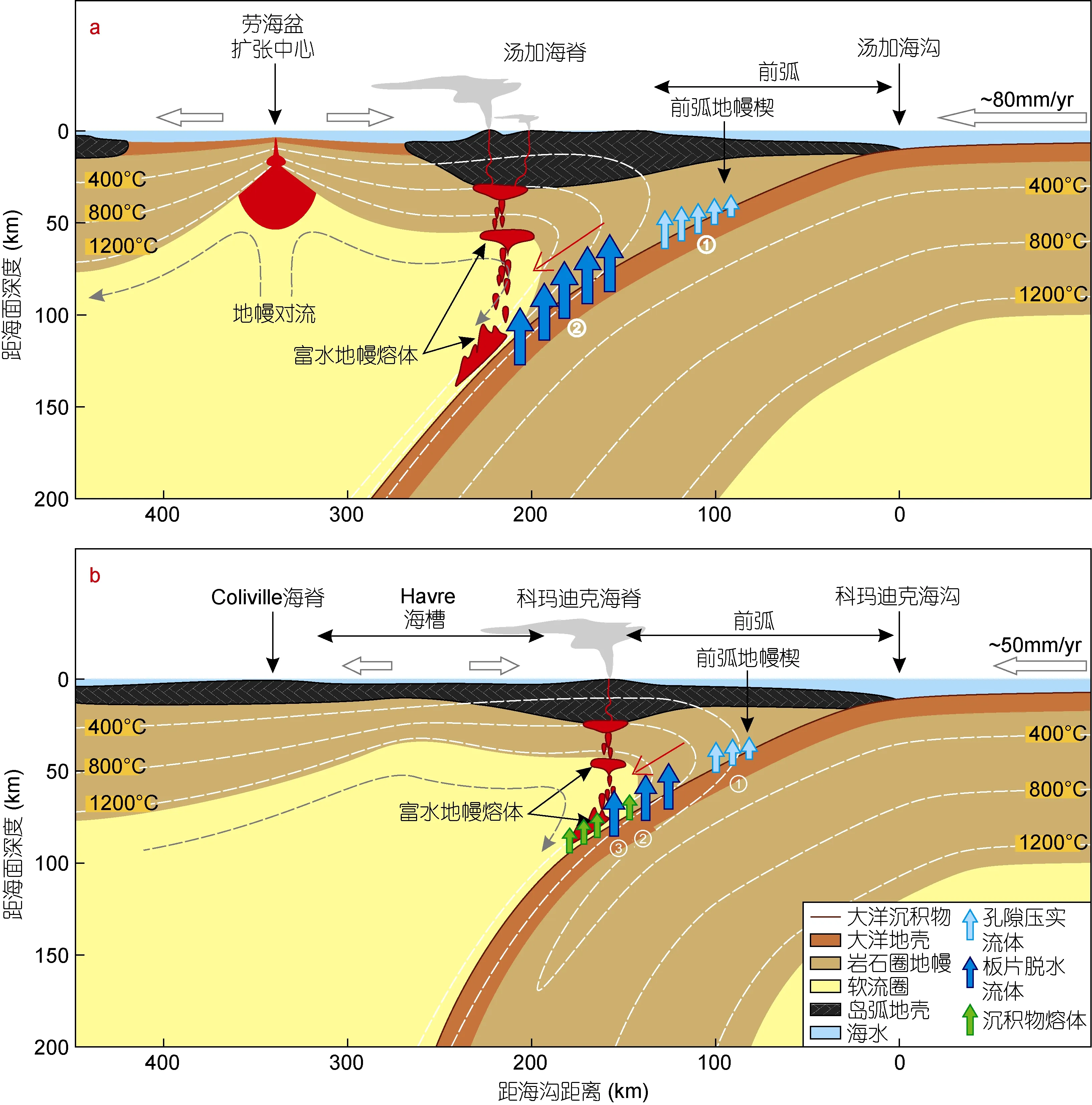
图3 板块俯冲速率对汤加-科玛迪克俯冲带岩浆作用的控制示意图(根据Luo et al, 2017修改)Fig.3 The control of plate subducting rate on Tonga-Kermadec system (Modified based on Luo et al, 2017)
2.4 雅浦岛弧的基岩性质
雅浦岛弧位于马里亚纳岛弧的南端。从雅浦岛弧发育结构看, 其具有比一般岛弧狭窄的海沟/岛弧距离。其中, 马里亚纳沟弧间距约100—150km, 而雅浦岛弧仅为50km(张正一等, 2017)。雅浦岛弧后也没有发育相应的弧后盆地(图 1)。一般认为, 雅浦岛弧保留了板块初始俯冲的岛弧形态(Matsudaet al, 1977)。实际上, 雅浦岛弧不仅在自身形态上与众不同, 其海沟前缘正在俯冲的板片也与一般俯冲带存在很大差别。在雅浦海沟前俯冲的是加洛林洋底高原, 这使得板块俯冲的速率很低(<6mm/yr)(Senoet al, 1993)。为查明雅浦岛弧海山的基岩性质, “海洋专项”对雅浦岛弧进行了基岩采样, 发现雅浦岛弧主要由变质岩组成, 包括角闪岩和少量绿片岩(未发表)。随后, 该项目对雅浦岛弧变质岩进行了电子探针微区分析, 采用角闪石单矿物温度压力计、斜长石-角闪石 Na-Ca交换温度计和角闪石-斜长石 Al-Si压力计来计算变质温度/压力(P/T)条件。计算结果表明: 雅浦岛弧角闪岩变质P/T条件为(560—780ºC)/(3—6Kbar), 为中等P/T型变质相系(未发表)。根据计算获得的变质温压条件, 研究认为雅浦岛弧至少经历了埋藏变质和变质岩出露两个过程。雅浦岛弧可能经历了岛弧火山岩被剥蚀的过程, 这个过程是由于加洛林洋底高原俯冲侵蚀导致的。这说明洋底高原的持续俯冲对岛弧产生了强烈侵蚀, 并最终将原岛弧物质带入俯冲带地幔中(张吉等, 2017)(图5)。
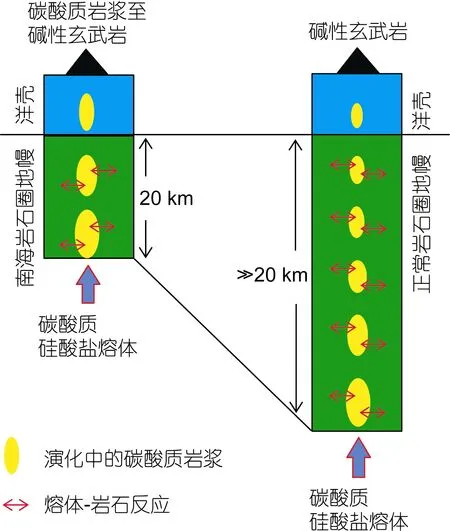
图4 碳酸岩质熔体向碱性玄武岩转化示意图(修改自Zhang et al, 2017)Fig.4 Evolution from carbonated melt to alkali basalt (modified from Zhang et al, 2017)
2.5 汤加-科玛迪克俯冲前缘板块年龄和成因
汤加-科玛迪克俯冲带前正在俯冲的板块介于Manihiki和 Hikurangi两个洋底高原之间, 一个东西向的残留扩张中心(Osbourn海槽)横穿板块(Zhanget al, 2012)。地磁条带研究显示, 这个板块形成于白垩纪正极性超时阶段(124—80Ma)。但板块的年龄和形成时的扩张速率长期以来不确定, 尤其是近年来研究显示这个板块的形成是在Manihiki和Hikurangi洋底高原形成后不久分离而形成的。Manihiki和Hikurangi洋底高原被认为是与Ontong Java同样形成于一个地幔柱(主要有 125Ma和 90Ma两期)(Taylor,2006)。尽管如此, 这个地幔柱与Osbourn扩张中心的关系一直不明确。IODP U1365站位于Osbourn残留脊的北侧 250km处。作者对 U1365玄武岩进行了Re-Os同位素研究, 结果显示玄武岩年龄为(103.7±2.3)Ma。根据该年龄计算获得的Osbourn扩张中心扩张速率至少为190mm/yr (Zhanget al, 2016)。据此, 本项研究认为, Osbourn扩张中心代表早期太平洋扩张中心的西段。Pb-Hf同位素结果也显示,IODP U1365站玄武岩也受到明显的地幔柱组分的影响(Zhanget al, 2016)。研究认为, 在Osbourn扩张中心扩张过程中的地幔源区受到Ontong Java地幔柱组分的影响。
3 结论
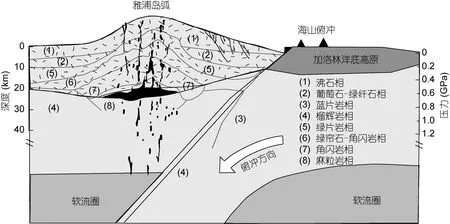
图5 雅浦岛弧下部岩石学结构恢复示意图Fig.5 Modeling showing lithological structure beneath the Yap arc
西太平洋在全球板块构造体系中占据重要地位。西太平洋集中了大量大洋内部形成的沟-弧-盆体系和板内火山活动。本文总结了西太平洋代表性岛弧俯冲带形成的构造背景、时代和洋内岛弧的可能成因以及西太平洋海盆形成时代和构造环境; 分析了主要岛弧和海盆的火山岩的岩石学和地球化学组成, 揭示了西太平洋的地幔Dupal异常分布特征; 总结了西太平洋板内火山作用的组成和分布特征(形成时代、岩石组成和成因)。通过综述分析, 也指出还有重要的地球科学问题还没有解决。这些科学问题包括: 西太平洋洋内岛弧形成基本机制、俯冲板块对岛弧岩浆的控制机理、弧后盆地Dupal异常的分布来源以及板内岩浆的成因等。在中国科学院“海洋专项”的资助下, 作者对西太平洋雅浦岛弧体系、加洛林洋脊、南中国海、汤加-科玛迪克俯冲带及前缘俯冲板块, 进行了岩石学、地球化学和年代学研究, 针对以上科学问题, 取得了一定成果: 雅浦岛弧基底主要为变质岩-角闪岩组成, 岛弧受到了强烈的加洛林板块的俯冲侵蚀; 汤加-科玛迪克岛弧火山岩直接反映了俯冲板片俯冲速率的影响, 阐明了俯冲大洋板块对岛弧岩浆作用的控制机理; 通过 Re-Os同位素测定了汤加-科玛迪克俯冲前缘板块的年龄为~103.7Ma, 最低扩张速率为190mm/yr, 代表了古太平洋扩张中心; 在南海发现碳酸盐化的硅酸岩岩浆向碱性玄武岩转化的现象,并为板内碱性玄武岩提出了新的成因链条; 西太平洋Dupal异常连续延伸至南中国海盆。这些新的认识,对认识西太平洋沟-弧-盆体系的成因和板内岩浆作用机理, 以及深刻理解西太平洋在板块构造体系中(板块俯冲导致的物质循环、板块构造动力学)的关键作用, 具有重要意义。
致谢感谢科学号全体船队员的通力合作和共同努力。
张正一, 董冬冬, 张广旭等, 2017. 板块俯冲侵蚀雅浦岛弧的地形制约. 海洋地质与第四纪地质, 37(1): 41—50
Abouchami W, Hofmann A W, Galer S J Get al, 2005. Lead isotopes reveal bilateral asymmetry and vertical continuity in the Hawaiian mantle plume. Nature, 434(7035): 851—856
Agranier A, Blichert-Toft J, Graham Det al, 2005. The spectra of isotopic heterogeneities along the mid-Atlantic Ridge. Earth and Planetary Science Letters, 238(1—2): 96—109
Arculus R, Bandini A N, Ishizuka Oet al, 2015b. International ocean discovery program expedition 351 preliminary report.International Ocean Discovery Program, 1—66
Arculus R J, Ishizuka O, Bogus K Aet al, 2015a. A record of spontaneous subduction initiation in the Izu-Bonin-Mariana arc. Nature Geoscience, 8(9): 728—733
Ballmer M D, Ito G, van Hunen Jet al, 2010. Small-scale sublithospheric convection reconciles geochemistry and geochronology of ‘Superplume’ volcanism in the western and South Pacific. Earth and Planetary Science Letters,290(1—2): 224—232
Bellon H, Rangin C, 1991. Geochemistry and isotopic dating of Cenozoic volcanic arc sequences around the Celebes and Sulu Seas. In: Proceedings of the Ocean Drilling Program,Scientific Results, Vol.124. College Station, TX: Ocean Drilling Program
Bird P, 2003. An updated digital model of plate boundaries.Geochemistry, Geophysics, Geosystems, 4(3): 1027, doi:10.1029/2001gc000252
Bowin C, Reynolds P H, 1975. Radiometric ages from Ryukyu Arc Region and an40Ar/39Ar age from biotite dacite on Okinawa. Earth and Planetary Science Letters, 27(3):363—370
Bracey D R, 1975. Reconnaissance geophysical survey of the Caroline Basin. Geological Society of America Bulletin,86(6): 775—784
Bracey D R, Andrews J E, 1974. Western Caroline Ridge: relic island arc? Marine Geophysical Researches, 2(2): 111—125
Briais A, Patriat P, Tapponnier P, 1993. Updated interpretation of magnetic anomalies and seafloor spreading stages in the South China Sea: implications for the tertiary tectonics of southeast Asia. Journal of Geophysical Research: Solid Earth, 98(B4): 6299—6328
Castillo P R, 1996. Origin and geodynamic implication of the Dupal isotopic anomaly in volcanic rocks from the Philippine island arcs. Geology, 24(3): 271—274
Castillo P R, Lonsdale P F, Moran C Let al, 2009. Geochemistry of mid-Cretaceous Pacific crust being subducted along the Tonga—Kermadec Trench: implications for the generation of arc lavas. Lithos, 112(1—2): 87—102
Chekhovich V D, Sukhov A N, Sheremet O Get al, 2012.Cenozoic geodynamics of the Bering Sea region.Geotectonics, 46(3): 212—231
Collot J Y, Lamarche G, Wood R Aet al, 1995. Morphostructure of an incipient subduction zone along a transform plate boundary: Puysegur Ridge and Trench. Geology, 23(6):519—522
Conrad C P, Bianco T A, Smith E Iet al, 2011. Patterns of intraplate volcanism controlled by asthenospheric shear.Nature Geoscience, 4(5): 317—321
Cooper A K, Marlow M S, Scholl D Wet al, 1992. Evidence for Cenozoic crustal extension in the Bering Sea region.Tectonics, 11(4): 719—731
Dale C W, Luguet A, Macpherson C Get al, 2008. Extreme platinum-group element fractionation and variable Os isotope compositions in Philippine Sea Plate basalts: tracing mantle source heterogeneity. Chemical Geology, 248(3—4):213—238
Dasgupta R, Hirschmann M M, Smith N D, 2007. Partial melting experiments of peridotite + CO2at 3 GPa and genesis of alkalic ocean island basalts. Journal of Petrology, 48(11):2093—2124
Dasgupta R, Hirschmann M M, Stalker K, 2006. Immiscible transition from carbonate-rich to silicate-rich melts in the 3 GPa melting interval of eclogite + CO2and genesis of silica-undersaturated ocean island lavas. Journal of Petrology, 47(4): 647—671
Deschamps A, Lallemand S, 2002. The West Philippine Basin: an Eocene to early Oligocene back arc basin opened between two opposed subduction zones. Journal of Geophysical Research: Solid Earth, 107(B12): EPM 1-1—EPM 1-24
Duncan M S, Dasgupta R, 2017. Rise of Earth’s atmospheric oxygen controlled by efficient subduction of organic carbon.Nature Geoscience, 10(5): 387—392
Dupré B, Allègre C J, 1983. Pb-Sr isotope variation in Indian Ocean basalts and mixing phenomena. Nature, 303(5913):142—146
Elliott T, 2003. Tracers of the slab. In: Eiler J ed. Inside the Subduction Factory. Washington, DC: American Geophysical Union, 138: 23—45
Ewart A, Collerson K D, Regelous Met al, 1998. Geochemical evolution within the Tonga-Kermadec—Lau arc—back-arc systems: the role of varying mantle wedge composition in space and time. Journal of Petrology, 39(3): 331—368
Ewart A, Hawkesworth C J, 1987. The Pleistocene-recent Tonga—Kermadec arc lavas: interpretation of new isotopic and rare earth data in terms of a depleted mantle source model. Journal of Petrology, 28(3): 495—530
Flower M F J, Russo R M, Tamaki Ket al, 2001. Mantle contamination and the Izu-Bonin-Mariana (IBM)‘high-tide mark’: evidence for mantle extrusion caused by Tethyan closure. Tectonophysics, 333(1—2): 9—34
Flower M, Tamaki K, Hoang N, 1998. Mantle extrusion: a model for dispersed volcanism and Dupal-Like asthenosphere in East Asia and the western Pacific. In: Mantle Dynamics and Plate Interactions in East Asia. Washington, DC: American Geophysical Union
Fujiwara T, Tamura C, Nishizawa Aet al, 2000. Morphology and tectonics of the Yap Trench. Marine Geophysical Researches,21(1—2): 69—86
Gaina C, Müller D, 2007. Cenozoic tectonic and depth/age evolution of the Indonesian gateway and associated back-arc basins. Earth-Science Reviews, 83(3—4): 177—203
Goldstein S L, Soffer G, Langmuir C Het al, 2008. Origin of a'Southern Hemisphere' geochemical signature in the Arctic upper mantle. Nature, 453(7191): 89—93
Hart S R, 1984. A large-scale isotope anomaly in the Southern Hemisphere mantle. Nature, 309(5971): 753—757
Hart S R, 1988. Heterogeneous mantle domains: signatures,genesis and mixing chronologies. Earth and Planetary Science Letters, 90(3): 273—296
Haston R, Fuller M, Schmidtke E, 1988. Paleomagnetic results from Palau, West Caroline Islands: A constraint on Philippine Sea plate motion. Geology, 16(7): 654—657
Haston R B, Fuller M, 1991. Paleomagnetic data from the Philippine Sea Plate and their tectonic significance. Journal of Geophysical Research, 96(B4): 6073—6098
Hawkins J, Batiza R, 1977. Metamorphic rocks of the Yap arc-trench system. Earth and Planetary Science Letters,37(2): 216—229
Hickey-Vargas R, 1998. Origin of the Indian Ocean-type isotopic signature in basalts from Philippine Sea plate spreading centers: an assessment of local versus large scale processes.Journal of Geophysical Research: Solid Earth, 103(B9):20963—20979
Hilde T W C, Lee C S, 1984. Origin and evolution of the West Philippine Basin: a new interpretation. Tectonophysics,102(1—4): 85—104
Hilde T W C, Uyeda S, Kroenke L, 1977. Evolution of the western Pacific and its margin. Tectonophysics, 38(1—2):145—165
Hirano N, Takahashi E, Yamamoto Jet al, 2006. Volcanism in response to plate flexure. Science, 313(5792): 1426—1428 Hoernle K, Hauff F, Werner Ret al, 2011. Origin of Indian Ocean Seamount Province by shallow recycling of continental lithosphere. Nature Geoscience, 4(12): 883—887
Hofmann A W, 1997. Mantle geochemistry: the message from oceanic volcanism. Nature, 385(6613): 219—229
Holloway N H, 1982. North Palawan Block, Philippines—its relation to Asian Mainland and role in evolution of South China Sea. AAPG Bulletin, 66(9): 1355—1383
Johnson M C, Plank T, 1999. Dehydration and melting experiments constrain the fate of subducted sediments.Geochemistry, Geophysics, Geosystems, 1(12): 1007
Jolivet L, Huchon P, Rangin C, 1989. Tectonic setting of western Pacific marginal basins. Tectonophysics, 160(1—4): 23—47 Karig D E, 1971. Origin and development of marginal basins in the western Pacific. Journal of Geophysical Research, 76(11):2542—2561
Karig D E, 1973. Plate convergence between the Philippines and the Ryukyu Islands. Marine Geology, 14(3): 153—168
Karig D E, 1974. Evolution of arc systems in the western Pacific.Annual Review of Earth and Planetary Sciences, 2: 51—75 Karig D E, 1975. Basin genesis in the Philippine Sea. In: Karig D E, Ingle J C Jr eds. Initial Reports, DSDP. Washington, DC:U.S. Government Printing Office, 31: 857—879
Keating B H, Mattey D P, Helsley C Eet al, 1984. Evidence for a hot spot origin of the Caroline Islands. Journal of Geophysical Research: Solid Earth, 89(B12): 9937—9948
Kelley K A, Plank T, Grove T Let al, 2006. Mantle melting as a function of water content beneath back-arc basins. Journal of Geophysical Research: Solid Earth, 111(B9): B09208
Kim Y M, Lee S M, Okino K, 2009. Comparison of gravity anomaly between mature and immature intra-oceanic subduction zones in the western Pacific. Tectonophysics,474(3—4): 657—673
King S D, 2011. Volcanism: eruptions above mantle shear. Nature Geoscience, 4(5): 279—280
Kipf A, Hauff F, Werner Ret al, 2014. Seamounts off the West Antarctic margin: a case for non-hotspot driven intraplate volcanism. Gondwana Research, 25(4): 1660—1679
Kobayashi K, 2004. Origin of the Palau and Yap trench-arc systems. Geophysical Journal International, 157(3):1303—1315
Kogiso T, Hirschmann M M, Frost D J, 2003. High-pressure partial melting of garnet pyroxenite: possible mafic lithologies in the source of ocean island basalts. Earth and Planetary Science Letters, 216(4): 603—617
Koppers A A P, Duncan R A, Steinberger B, 2004. Implications of a nonlinear40Ar/39Ar age progression along the Louisville seamount trail for models of fixed and moving hot spots.Geochemistry, Geophysics, Geosystems, 5(6): Q06L02
Korenaga J, 2013. Initiation and evolution of plate tectonics on Earth: theories and observations. Annual Review of Earth and Planetary Sciences, 41: 117—151
Lapierre H, Taylor R N, Rouer Oet al, 1992. Mineral chemistry of forearc volcanic rocks from the Ize-bonin arc, Holes 792E and 793B1. In: Proceedings of the Ocean Drilling Program,Scientific Results, Vol.12. College Station, TX: Ocean Drilling Program
Larson R L, 1997. Superplumes and ridge interactions between Ontong Java and Manihiki Plateaus and the Nova-Canton Trough. Geology, 25(9): 779—782
Lee C S, McCabe R, 1986. The Banda-Celebes-Sulu basin: a trapped piece of Cretaceous-Eocene oceanic crust? Nature,322(6074): 51—54
Lenardic A, Crowley J W, 2012. On the notion of well-defined tectonic regimes for terrestrial planets in this solar system and others. The Astrophysical Journal, 755(2): 132
Li C F, Xu X, Sun Zet al, 2014. Ages and magnetic structures of the South China Sea constrained by deep tow magnetic surveys and IODP Expedition 349. Geochemistry,Geophysics, Geosystems, 15(12): 4958—4983
Luo Q, Zhang G L, 2017. Control of subduction rate on Tonga-Kermadec arc magmatism. Chinese Journal of Oceanology and Limnology, doi: 10.1007/s00343-018-7026-8
Matsuda J I, Zashu S, Ozima M, 1977. Sr isotopic studies of volcanic rocks from island arcs in the western Pacific.Tectonophysics, 37(1—3): 141—151
McCabe R, Almasco J, Diegor W, 1982. Geologic and paleomagnetic evidence for a possible Miocene collision in western Panay, central Philippines. Geology, 10(6):325—329
McCabe R, Uyeda S. 1983. Hypothetical model for the bending of the Mariana Arc. In: Hayes D E ed. The Tectonic and Geologic Evolution of Southeast Asian Seas and Islands:Part 2. Washington, DC: AGU, 27: 281—293
McKee E H, 1975. K-Ar ages of deep-sea basalts, Benham rise,west Philippine basin, leg 31, deep sea drilling project. In:Initial Reports of DSDP. College Station, TX, United States:Ocean Drilling Program, 31: 909—929
McNutt M K, Caress D W, Reynolds Jet al, 1997. Failure of plume theory to explain midplate volcanism in the southern Austral islands. Nature, 389(6650): 479—482
Metcalfe I, 2011. Tectonic framework and Phanerozoic evolution of Sundaland. Gondwana Research, 19(1): 3—21
Mitchell A H G, Hernandez F, Cruz A P D, 1986. Cenozoic evolution of the Philippine Archipelago. Journal of Southeast Asian Earth Sciences, 1986, 1(1): 3—22
Miyazaki T, Kimura J I, Senda Ret al, 2015. Missing western half of the Pacific Plate: geochemical nature of the Izanagi-Pacific Ridge interaction with a stationary boundary between the Indian and Pacific mantles. Geochemistry,Geophysics, Geosystems, 16(9): 3309—3332
Mrozowski C L, Hayes D E, 1979. The evolution of the Parece Vela Basin, Eastern Philippine Sea. Earth and Planetary Science Letters, 46(1): 49—67
Mueller S, Phillips R J, 1991. On the initiation of subduction.Journal of Geophysical Research: Solid Earth, 96(B1):651—665
Müller C, 1991. Biostratigraphy and geological evolution of the Sulu sea and surrounding area. In: Proceedings of the Ocean Drilling Program, Scientific Results. College Station, TX:Ocean Drilling Program, 124: 121—131
Murauchi S, Ludwig W J, Den Net al. 1973. Structure of the Sulu Sea and the Celebes Sea. Journal of Geophysical Research, 78(17): 3437—3447
Nichols G, Hall R, 1999. History of the Celebes Sea Basin based on its stratigraphic and sedimentological record. Journal of Asian Earth Sciences, 17(1—2): 47—59
Nimmo F, Stevenson D J, 2000. Influence of early plate tectonics on the thermal evolution and magnetic field of Mars. Journal of Geophysical Research: Planets, 105(E5): 11969—11979 Ohara Y, Fujioka K, Ishizukaet al, 2002. Peridotites and volcanics from the Yap arc system: implications for tectonics of the southern Philippine Sea Plate. Chemical Geology,189(1—2): 35—53
Okino K, Ohara Y, Kasuga Set al, 1999. The Philippine Sea: new survey results reveal the structure and the history of the marginal basins. Geophysical Research Letters, 26(15):2287—2290
Parson L M, Hawkins J W, 1994. Two-stage ridge propagation and the geological history of the Lau backarc basin. In: Proc.ODP, Scientific Results. College Station, TX: Ocean Drilling Program, 135: 819—828
Parsons B, Sclater J G, 1977. An analysis of the variation of ocean floor bathymetry and heat flow with age. Journal of Geophysical Research, 82(5): 803—827
Peacock S M, 1990. Numerical simulation of metamorphic pressure-temperature-time paths and fluid production in subducting slabs. Tectonics, 9(5): 1197—1211
Peacock S M, 1996. Thermal and petrologic structure of subduction zones. In: Gray E B ed. Subduction Top to Bottom. Washington, DC: American Geophysical Union, 96:119—113
Pearce J A, Peate D W, 1995. Tectonic implications of the composition of volcanic arc magmas. Annual Review of Earth and Planetary Sciences, 23: 251—285
Pearce J A, Aaron J A, Reagan M Ket al, 2015. International ocean discovery program expedition 352 preliminary report.In: International Ocean Discovery Program, Preliminary Report. International Ocean Discovery Program, 1—86
Price A A, Jackson M G, Blichert-Toft Jet al, 2016. Geochemical evidence in the northeast Lau basin for subduction of the cook-austral volcanic chain in the Tonga trench.Geochemistry, Geophysics, Geosystems, 17(5): 1694—1724
Rangin C, 1989. The Sulu Sea, a back-arc basin setting within a Neogene collision zone. Tectonophysics, 161(1—2): 119—141
Reagan M K, McClelland W C, Girard Get al, 2013. The geology of the southern Mariana fore-arc crust: implications for the scale of Eocene volcanism in the western Pacific.Earth and Planetary Science Letters, 380: 41—51
Regelous M, Collerson K D, Ewart Aet al, 1997. Trace element transport rates in subduction zones: evidence from Th, Sr and Pb isotope data for Tonga-Kermadec arc lavas. Earth and Planetary Science Letters, 150(3—4): 291—302
Roeser H A, 1991. Age of the crust of the Southeast Sulu Sea basin based on Magnetic anomalies and age determined at Site 768. In: Proceedings of the Ocean Drilling Program,Scientific Results. College Station, TX: Ocean Drilling Program, 124: 339—44
Sato T, Matsu'ura M, 1993. A kinematic model for evolution of island arc-trench systems. Geophysical Journal International,114(3): 512—530
Scott R, Kroenke L, Zakariadze G, 1980. Evolution of the south Philippine Sea: Deep Sea Drilling Project Leg 59 Results. In:International Ocean Discovery Program, Preliminary Report.International Ocean Discovery Program, 803—815
Seno T, Stein S, Gripp A E, 1993. A model for the motion of the Philippine Sea plate consistent with NUVEL-1 and geological data. Journal of Geophysical Research: Solid Earth, 98(10): 17941—17948
Seton M, Flament N, Whittaker Jet al, 2015. Ridge subduction sparked reorganization of the Pacific plate mantle system 60-50 million years ago. Geophysical Research Letters,42(6): 1732—1740
Shih T C, 1980. Magnetic lineations in the shikoku basin. In:Proceedings of the Deep Sea Drilling Project, Scientific Results. Washington, DC: U.S. Government Printing Office,58: 783—788
Shiraki K, Kuroda N, Maruyama Set al, 1978. Evolution of the tertiary volcanic rocks in the Izu-Mariana arc. Bulletin Volcanologique, 41(4): 548—562
Shiraki, Keiichi. 1971. Metamorphic basement rocks of Yap Islands, Western Pacific: possible oceanic crust beneath an island arc.Earth and Planetary Science Letters, 13: 167—174.
Shyu J P, Merrill D, Hsu Vet al, 1991. Biostratigraphic and magnetostratigraphic synthesis of the Celebes and Sulu Seas,Leg 124. In: Proceedings of the Ocean Drilling Program,Scientific Results. College Station, TX: Ocean Drilling Program, 124: 11—38
Sobolev A V, Hofmann A W, Sobolev S Vet al, 2005. An olivine-free mantle source of Hawaiian shield basalts.Nature, 434(7033): 590—597
Spadea P, D’Antonio M, Thirlwall M F, 1996. Source characteristics of the basement rocks from the Sulu and Celebes Basins (Western Pacific): chemical and isotopic evidence. Contributions to Mineralogy and Petrology, 123(2):159—176
Stern R J, Fouch M J, Klemperer S L, 2003. An overview of the Izu-Bonin-Mariana subduction factory. In: Inside the Subduction Factory. Washington, DC: American Geophysical Union, 138: 175—222
Suetsugu D, Isse T, Tanaka Set al, 2009. South Pacific mantle plumes imaged by seismic observation on islands and seafloor. Geochemistry, Geophysics, Geosystems, 10(11):Q11014
Sun W D, Ding X, Hu Y Het al, 2007. The golden transformation of the Cretaceous plate subduction in the west Pacific. Earth and Planetary Science Letters, 262(3—4): 533—542
Sun W D, Lin C T, Zhang C Cet al, 2016. Initiation and evolution of the South China Sea: an overview. Acta Geochimica, 35(3): 226
Syracuse E M, van Keken P E, Abers G A, 2010. The global range of subduction zone thermal models. Physics of the Earth and Planetary Interiors, 183(1—2): 73—90
Tamaki K, Suyehiro K, Allan J, 1992. Tectonic synthesis and implications of Japan sea ODP Drilling. In: Proceedings of the Ocean Drilling Program, Scientific Results. College Station, TX:Ocean Drilling Program, 127—128: 1334—1349
Taylor B, 1979. Bismarck Sea: Evolution of a back-arc basin.Geology, 7(4): 171—174
Taylor B, 2006. The single largest oceanic plateau: Ontong Java—Manihiki—Hikurangi. Earth and Planetary Science Letters, 241(3—4): 372—380
Taylor B, Hayes D E, 1982. Origin and history of the South China Sea Basin. In: Hayes DE ed. The Tectonic and Geologic Evolution of Southeast Asian Seas and Islands:Part 2. Washington, DC: American Geophysical Union, 27:23—56
Taylor B, Karner G D, 1983. On the evolution of marginal basins.Reviews of Geophysics, 21(8): 1727—1741
Taylor B, Zellmer K, Martinez Fet al, 1996. Sea-floor spreading in the Lau back-arc basin. Earth and Planetary Science Letters, 144(1—2): 35—40
Timm C, Bassett D, Graham I Jet al, 2013. Louisville seamount subduction and its implication on mantle flow beneath the central Tonga—Kermadec arc. Nature Communications, 4:1720
Tu K, Flower M F, Carlson R Wet al, 1992. Magmatism in the South China Basin: 1. Isotopic and trace-element evidence for an endogenous Dupal mantle component. Chemical Geology, 97(1—2): 47—63
Turner S, Handler M, Bindeman Iet al, 2009. New insights into the origin of O—Hf—Os isotope signatures in arc lavas from Tonga—Kermadec. Chemical Geology, 266(3—4):187—193
Turner S, Hawkesworth C, Rogers Net al, 1997.238U-230Th disequilibria, magma petrogenesis, and flux rates beneath the depleted Tonga-Kermadec island arc. Geochimica et Cosmochimica Acta, 61(22): 4855—4884
Uyeda S, Ben-Avraham Z, 1972. Origin and development of the Philippine Sea. Nature Physical Science, 240(104):176—178
Uyeda S, Kanamori H, 1979. Back-arc opening and the mode of subduction. Journal of Geophysical Research: Solid Earth,84(B3): 1049—1061
van Keken P E, Hacker B R, Syracuse E Met al, 2011.Subduction factory: 4. Depth-dependent flux of H2O from subducting slabs worldwide. Journal of Geophysical Research: Solid Earth, 116(B1): B01401
van Keken P E, Kiefer B, Peacock S M, 2002. High-resolution models of subduction zones: implications for mineral dehydration reactions and the transport of water into the deep mantle. Geochemistry, Geophysics, Geosystems, 3(10):1056
Verzhbitsky E V, Kononov M V, 2006. Geodynamic evolution of the lithosphere of the Sea of Okhotsk region from geophysical data. Izvestiya, Physics of the Solid Earth, 42(6):490—501
Weissel J K, Anderson R N, 1978. Is there a Caroline plate? Earth and Planetary Science Letters, 41(2): 143—158
Zellmer G F, Edmonds M, Straub S M, 2015. Volatiles in subduction zone magmatism. Geological Society, London,Special Publications, 410(1): 1—17
Zhang G L, Smith-Duque C, Tang S Het al, 2012. Geochemistry of basalts from IODP site U1365: implications for magmatism and mantle source signatures of the mid-Cretaceous Osbourn Trough. Lithos, 144—145: 73—87
Zhang G L, Chen L H, Jackson M Get al, 2017. Evolution of carbonated melt to alkali basalt in the South China Sea.Nature Geoscience, 10(3): 229—235
Zhang G L, Li C, 2016. Interactions of the Greater Ontong Java mantle plume component with the Osbourn Trough.Scientific Reports, 6: 37561
Zhou X M, Li W X, 2000. Origin of Late Mesozoic igneous rocks in Southeastern China: implications for lithosphere subduction and underplating of mafic magmas.Tectonophysics, 326(3—4): 269—287

